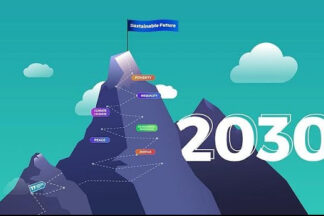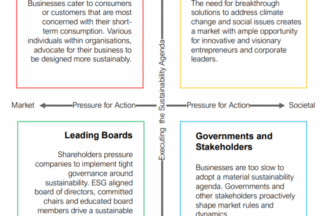This time around I want to make it explicit: If a company is not performing in sustainability terms, it as good as always down to senior leadership. Both, executive leadership – CEO, COO, CFO, CMO,
CSO etc. - as well as non-executive leadership at board level.
For one, arguably simplistic, reason: sustainability deliverables are oversteered by
‘higher priority’ KPIs. And what does mean? Fundamentally, it is down to decisions where the ball stops at the top leadership level.
Do you recognise these scenarios?
Most companies have had a brush with sustainability (or it’s finance industry lens: ESG) at the very least on an operational level. Not necessarily always voluntarily or out of conviction, mind.
Looking at corporate boards however, the picture starts to change – not necessarily to the better. While boards of listed companies may have been forced to look at non-financial disclosure, it is rare that any board has a sound grasp, never mind approach, to all things ESG and sustainability.
This is why I list in this post the few tools I am aware of that are specifically targetting and intended to help corporate boards start on the journey towards becoming climate and SDG savvy.
Over the last couple of years a plethora of pledges has arisen in the sustainability/ESG space.
The weird thing: Pledges intend to drive change the wrong way around. Commit people (read: companies) publicly, then hope they will actually move in accordance to the pledge/commitment, and then only hold them to account if and when they do not delivery. If anyone remembers that is.
Do we need all these pledges? Do they really make a difference?
Data says: probably not ...
Shouldn't hence the Lemma simply be:
Actions before words.
Impact before messaging.
Walk before talk.
Science before marketing.
If you’ve ever been part of a bigger discourse about how to scale out sustainability economically and globally, you’ll have been quick to notice that by and large you’ll be faced with representatives of four distinct camps of advocates:
The Grassrooters; the 'Setting the tone at the top' people; those in support of government regulation driven by civil society; and the 'Fiduciary Duty Advocates'.
But which camp owns the driving leadership role? Funnily enough, that role does get handed around as if it was a game of musical chairs ... or the proverbial hot potato.
Most boards are composed of former or present CEOs, CFO and other C-suite executives.
People, hence, with a long track record of ‘getting stuff’ done. A board’s role however is very different from that of an executive: digging deep by asking those overly simple questions that give interesting answers, digging deep into rationales, values, hopes, expectations, shut up doubts, and personal agendas. Which is what good coaches typically do. Are coaches the better board directors?
Corporate responsibility, business ethics, sustainability, ESG. Whatever the terminology there are three fundamental questions that underpin all decisions, actions, strategies in this regard. These questions are strategically relevant for any board of directors. Because they are the basis upon which fiduciary duty is constructed. And: they outline the framework within which the fiduciary duty of a board is bound to evolve over time.
One of the things usually approved at the constituent board meeting after every company AGM are the board of directors' ‘Rules of Procedure’. What looks, and is often perceived, as a formality though, at close looks carries not just formal weight, but indeed formulates – directly or between the lines – the duties of the board.
What do these rules typically enshrine - and what not?
The influence of decision bias is nothing new when scrutinising corporate governance. And yet: by and large businesses continue to fail to adjust their strategic decision-making processes to become more climate viable. At best they have just barely started on their journey. Why is that? As we look deeper into the corporate discourse on Climate Change, it becomes evident that one of the silent yet crucial culprits behind the climate change inertia lies in the cognitive biases at play in corporate decision making. What are those biases, what do they mean for boards in the context of strategic Climate Change decisions, and what can be done about it?
A recent Bloomberg article found: of more than 600 directors and executives of the world’s 20 largest banks, only few individuals had experience in renewable or sustainable industries. Far more had ties to polluting industries: At least 73 individuals even have at one time or another held a position with one or more of the biggest corporate emitters of greenhouse gases, including 16 connected to oil or refining companies.
The irony: it is precisely the directors’ prior track record and experience, one of the very reasons why they got (s)elected onto the board, that could jeopardise their board’s forward decisions.
Expertise is a key discussion topic when it comes to board composition. Not only during the hiring process, but also when looking at the tenure in and renewal processes of board. According to a recent article by Board Agenda: a number of risks that have raised Directors & Officers concerns, and even litigation. These include [...] climate change and environmental issues; the #MeToo movement and other societal risks and merger objection litigation. Hence the question is: How sustainability (ESG) savvy and capable are boards?
Diversity and Inclusion is a highly relevant topic not ‘just’ because it is all about equality and justice. But as long as entire parts of our global population remain disenfranchised, and desperate to just survive from day to day, tackling challenges - and in particular Climate Change - that affect all of us, indiscriminately, remains impossible. Boards of Directors set out the "Tone at the Top', also in matter of diversity and inclusion. In fashion companies, what exactly is the tone, the music, that they are creating?
Research has known for a while that when someone in your presence is trying to think, much of what you are hearing and seeing is your effect on them. That is also the case for boards.
Because: under the right conditions and circumstances, people will – invariably – think for themselves. Just: is that desired?
There are two approaches on how we can define of what is viable and desirable for our global economy.
In one, the 'soft attributes' and non-physical factors such as consumer desires, lifestyles or distribution of goods are a fixed attribute. In the other, quantifiable, physical attributes - amongst them natural resources - are fixed.
The challenge of boards in this time and age: Recognising that the first - the present - is failing. And outlining the path towards the second.
In mountaineering there are three distinct methods to handle the rope. Each technique has some distinct application characteristics. And as a consequence, a direct impact on the team work, team effectiveness - and even survival. What can boards learn from alpine roping techniques?















